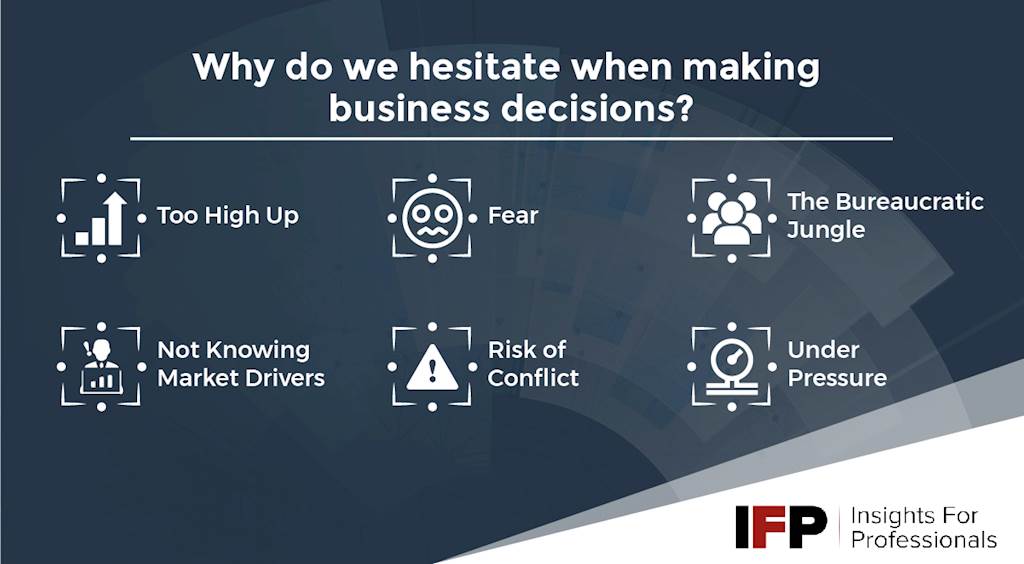The message is key in the corporate environment, as leaders around the world try to make decisions each day which directly impact upon employees, customers and the marketplace. Hesitation on these decisions can cause any number of missed opportunities.
The ability to choose the right path without losing momentum is a skill which can be honed through education and adhering to certain practices.
Read on to find out:
- Why we hesitate when making business decisions
- The impact of hesitation
- How to make effective business decisions
Why do we hesitate when making business decisions?
Too high up
Writing for the Harvard Business Review, industry commentator and author, Peter F Drucker, does not consider most executives to be great at making decisions because they pivot from their all-seeing position as company head.
Drucker finds that many executives take a strategic approach with the whole firm in mind, rather than engaging with a problem at ground level. As a result, leaders get bogged down in variables which ultimately leads to sloppy thinking and poor decision making.
Fear
Many business leaders are very good at suppressing emotions. While this can be very important in some capacities, silently overthinking perceived personal and professional risks and rewards is not conducive to making a snappy decision. Some of these elements are rational, but entrepreneur and investor Ravin Gandhi suggests the odds are stacked in the favor of those who just do it. Gandhi emphasizes how there’s never a right time to be pro-active, and asserts that the fear you hold within is far greater than the opportunity cost that you think you’re giving up.
The bureaucratic jungle
According to Ron Ashkenas, group mentality is a major hindrance on good decision making. Meetings, committees, presentations, emails and impressive intentions appear decisive, but they can become a jungle of paraphernalia which actually prevents a clear-cut decision from being made swiftly.
Risk of conflict
Beneath this storm of bureaucracy swirl undercurrents of dislike for conflict among staff members. Very often, you may perceive simulated camaraderie, displayed by people who subsequently fail to follow through on decisions that they never bought into in the first place.
Managers, too, can fall into the trap of not voicing an opinion strongly to avoid falling out with individuals or departments. However, this can easily lead to poor communication and decisions not being taken.
Not knowing market drivers
Research by EY finds that poor knowledge can also hinder decision-making. If executives are not familiar with value-driving forces, they may fail to link strategy, resource allocation, planning and reporting. Relying too heavily on instinct and brief analysis, time is wasted because an unclear rationale is allowed to percolate through the rest of the workforce.
Pressure
Companies under pressure to live up to past performance are hotbeds for slow and inefficient decision-making. The same EY study finds that in the brand new order, two-thirds of consumer product companies feel under pressure to reappraise their operating models, and almost three-quarters believe significant changes are needed just to sustain historic margins.

How to Make Effective Business Decisions
While causes differ, slow decision-making impacts negatively on costs, productivity and customer service while compromising a company’s agility. So how can managers put the speed back into the way they make choices?
Better data analysis
Businesses might understand the forces that drive value, but EY studies conclude that few firms have achieved anywhere near their potential when it comes to monitoring the impact of the most significant drivers across a range of dimensions.
EY champions drive analytics to transform information into strategic insight. For this to be achieved, market, competitor, operational and financial forces that really drive value creation need to be identified. Then these factors need to be correlated to produce outcome metrics such as market share, revenue or margin. Thus, insight turns decision-making into a standard, repeatable and integrated process across the business.
Managerial experience
Good leaders know the difference between a decision being carried out, and the noise masquerading as proactivity that surrounds a decision not being made.
Effective executives know that unless a decision has degenerated into work, it is not a decision; it is at best a good intention. Those at the top need to move closer to those lower down the hierarchy and see whether the fallout of a decision is defined by real steps forward or by the whirring of familiar time-wasting mechanisms.
Practice
Of course, only practice makes executives perfect at decision-making. One means of becoming better, as outlined by Gayle Abbott, president of Strategic Alignment Partners involves following this four-point strategy.
- Identify the problems
- Analyze the possible solutions
- Evaluate the possibilities that are likely to bring you closer to your goal
- Make the decision
This process might take years to hone, which is something executives need to bear in mind as they track their own progress as decision-makers. It is so easy to overlook just how much trial-and-error has gone into creating a successful individual’s excellent decision-making skills. Furthermore, while every good executive has made mistakes on their journey to the top, they have also become well practiced in dusting themselves down and carrying on.
Ultimately, risks should be taken, but only when all information and resources have been pooled, giving the best possible chance of making a right choice.
Decision-making matrix
A decision matrix is a table used to evaluate possible alternatives to a course of action, which can help leaders assess and organise all their options. These tools are especially useful when no clear path appears to exist.
A decision matrix works by taking subjectivity from the decision-making process while forensically comparing all relevant factors to reach a final conclusion. LaunchExcel, Mindtools and iSixSigma each carry useful matrix templates that can help with your prioritisation process.
Conclusion
Poor decision-making at an executive level is a critical flaw if left unattended. Its negative repercussions include procrastination within teams and jaded department heads, and can easily put an entire firm’s direction in jeopardy.
While no companies can afford to let decision-making drift, only fully embracing a move to improve decision-making will bring incrementally larger, real and measurable results that benefit firms from top to bottom.
Access the latest business knowledge in Management
Get Access






Comments
Join the conversation...